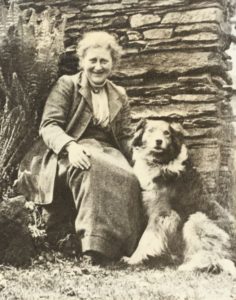As we draw to the end of another year, it is hard not to reflect on the past twelve months. It has certainly been a year of landmark anniversaries. We have marked the 400 years since the death of Shakespeare, 350 years since the Great Fire of London, and remembered those momentous events exactly 100 years ago on the 1st July 2016 with the centenary of the Battle of the Somme. In Wales, we have been celebrating the 100th anniversary of the birth of Roald Dahl. The Captial has been buzzing all year with literary events for authors and citywide events for all ages. Yet, we cannot end 2016 without mentioning the special anniversary of another best-selling children’s author. This writer brought to life the story of a very naughty little rabbit named Peter. We are, of course, talking of Beatrix Potter Рthe author of the much-loved Peter Rabbit books. People all across the UK have been celebrating her 150th birthday this year with special exhibitions and events. The Royal Mint have even commissioned special fifty pence coins to celebrate her achievements.
Helen Beatrix Potter was born on 28th July 1866 in Kensington, London, to a wealthy family. Beatrix found childhood restrictive and often lonely. The rare visits to the South Kensington Museum (now the V&A), the Natural History Museum, and the Royal Academy with her father helped to encourage her artistic talent. The little girl was inspired to fill sketchbook upon sketchbook with drawings of animals and plants from the age of eight onwards. Annual holidays in the Lake District gave her the chance to roam the countryside freely and practice her self-taught artistic skills further. Among the fields and trees, she was able to observe, sketch, catch, and even dissect a wide variety of animals and birds. Some of her observational drawings are on display at the Armitt Museum in Ambleside. This small museum is nestled into a corner of the tiny village and is not far from where Beatrix Potter would spend her childhood holidays. The drawings show how the Lake District helped her develop into a talented naturalist. She became particularly interested in fungi and even wrote a paper On the Germination of the Spores of Agricineae in 1897 with the help of her uncle. Sadly, her theories were rejected, probably due to her amateur status and gender.
It was at this point, however, that her paintings and drawings had started to earn her a modest income. This is where she now turned her attention. Beatrix started to write illustrated letters to the children of her former governess in the 1890s. It was in these letters that Peter Rabbit was born. Beatrix would borrow the letter seven years later and copy the illustrations to produce a rough version of what would eventually become The Tale of Peter Rabbit. There was a fair way to go before her works were published though. It took six rejections from six publishers before Beatrix decided to publish her own edition in 1901. This led to Federick Warne taking on the project and publishing the little book. Within the space of a year, the book went through six editions, just to meet public demand.
The revenue received from her published creation allowed Beatrix to buy Hill Top Farm in the Lake District. It was here that she began to learn the business of farming. She would continue to write during this period, and for the next eight years, Beatrix would produce two of her “little books” each year.
The popularity of her books allowed Beatrix Potter to expand her estate. Beatrix fulfilled her ambition to preserve the unique Lake District landscape as a result, and worked to keep traditional farming methods alive. When Beatrix Potter died on the 22nd December 1943, at the age of 77, she left all fourteen of her farms to the National Trust. This gesture ensured that approximately 4000 acres of the Lake District landscape was protected and the National Trust still own the land Beatrix bequeathed to them 73 years later. They continue her legacy of protecting the land from development and preserving the landscape.
Beatrix Potter was a truly remarkable woman. There are very few women who were published within their lifetime during the 1800s, and Beatrix was one of those women. In her lifetime, she wrote and illustrated 28 “little books” that included 23 tales. These books have sold over 100 million copies and have been translated into more than 35 different languages. Beatrix Potter remains to this day one of the world’s best-selling children’s authors. She was, however, more than just an author. Beatrix became an expert in breeding Herdwicks Рthe local sheep indigenous to Cumbria – and we owe her thanks for her efforts to preserve the Lake District. It is because of Beatrix Potter that we continue to have one of the most beautiful landscapes in the world.
-Claire Amundson
Junior Girl
Girl Museum Inc.

